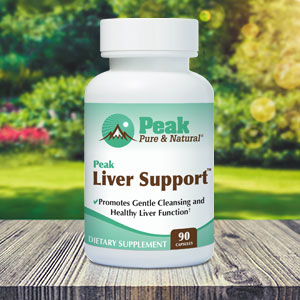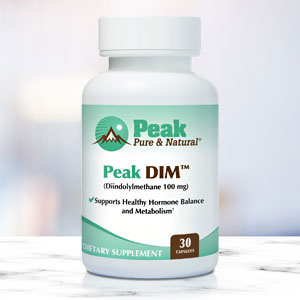Get Easy Health Digest™ in your inbox and don’t miss a thing when you subscribe today. Plus, get the free bonus report, Mother Nature’s Tips, Tricks and Remedies for Cholesterol, Blood Pressure & Blood Sugar as my way of saying welcome to the community!
15 chemicals linked to early menopause

We’ve long known that menopause brings with it an increased risk of numerous health issues, including heart disease, stroke, osteoporosis, asthma, weight gain and nonalcoholic fatty liver disease.
But for women who experience early menopause (before the age of 50), the risks carry an extra wallop…
The chances of suffering osteoporosis and cardiovascular events like heart attack and stroke are even higher.
Plus, early menopause puts you at greater risk of sleep disturbances, type 2 diabetes and decreased cognitive function later in life, as well as all-cause mortality.
Fortunately, it’s uncommon for women to go through menopause before age 50. Premature menopause or loss of normal ovary function occurs in about 1 percent of women under the age of 40, while 5 percent of women younger than 45 go through what is defined as early menopause.
In some cases, early or premature menopause is brought on by surgical removal of the ovaries or treatments like chemotherapy. In others, the ovaries simply stop releasing eggs prematurely and no cause can be found.
However, there is evidence that suggests there may be environmental factors contributing to earlier onset of menopause — some of which may be lurking in your own home right now….
As many as 15 chemicals linked to early menopause
Studies have shown that women with high levels of certain endocrine-disrupting chemicals (EDCs) in their bodies experience menopause two to four years earlier than women with lower levels.
These EDCs can be found in the environment, common household items and beauty products. They have already been linked to metabolic syndrome, a group of conditions that includes high blood pressure, increased body fat around the waist and high cholesterol, as well as early puberty in young girls.
Researchers have identified 15 EDCs linked to an earlier onset of menopause. Nine are polychlorinated biphenyls such as PCBs and coolants. PCBs were used in the U.S. until the late 1970s in a variety of industrial applications, including electrical transformers, hydraulic fluids, lubricants and paper. And PCBs can still be found in some electrical equipment in use today.
Because PCBs are slow to break down, traces can still be found in soil, particularly soil at the bottom of lakes and riverbeds. From there, these chemicals have entered the food chain by contaminating fish and invertebrates like shellfish and moving into birds and mammals who consume these organisms.
Three of the identified EDCs are pesticides that haven’t been used in the U.S. for decades but can still be found in trace amounts in water and soil. One of them, DDE, is actually a product resulting from the breakdown of DDT, a highly toxic pesticide used to control disease-bearing mosquitoes. Beta-HCH was used on cotton plants to control pests. And the third, mirex, was used as both an insecticide and a fire retardant in plastics, rubber, paint, paper and electrical appliances.
As for the remaining three EDCs, two are phthalates found in plastics, common household items, pharmaceuticals and personal care products. And one is a toxic chemical known as furan found in cigarette smoke, resins and lacquers, agrochemicals and pharmaceuticals.
Women with the highest levels of these EDCs in their blood recorded their last menstrual period 1.9 to 3.8 years earlier than those whose blood levels of these chemicals were on the lower end.
Researchers believe EDCs may diminish ovarian function in several ways. One possibility is that EDCs slowly damage the “pool” of egg-releasing follicles, leading to earlier menopause. In one study of couples, exposure to several of the same PCBs identified as EDCs was connected with a 20 percent reduction in ability to conceive. In another study, mice exposed to diesel exhaust showed a significant decrease in follicle proportion, resulting in diminished ovarian reserve and an increased risk of premature menopause.
The researchers say further study in animal models is needed to better understand the ways in which each of these 15 chemicals disrupts endocrine function.
Can you dodge these dangerous chemicals?
It can be difficult to completely avoid exposure to these chemicals because many are in the soil, water and air. But it’s important to find out exactly what’s in the cosmetics, personal care products, food packaging and other household products we use. That way, we can make choices that help reduce our chemical exposure.
For instance, when microwaving food, it’s best to use glass containers instead of plastic or surfactant-lined cardboard food containers. When purchasing personal care products and cosmetics, take a look at the labels and see if you can identify any phthalates. And buy organic whenever you can to avoid pesticide residues, which don’t rinse off in cold water.
There are also ways to get rid of the chemicals already accumulated inside your body. Certain vegetables can help remove chemicals like phthalates by binding to the chemicals and removing them from the body in a process called chelation. So add some broccoli, Brussels sprouts, cabbage, cauliflower, arugula and dark leafy greens like kale to your diet to help detoxify your body.
Editor’s note: Did you know that when you take your body from acid to alkaline you can boost your energy, lose weight, soothe digestion, avoid illness and achieve wellness? Click here to discover The Alkaline Secret to Ultimate Vitality and revive your life today!
Sources:
Earlier Age at Menopause Linked to Chemicals in Common Household Products and the Environment — endocrineweb
Persistent Organic Pollutants and Early Menopause in U.S. Women — PLoS One
PCBs in fish and shellfish — Environmental Defense Fund
DDE — Environmental Protection Agency
Pesticide Exposure Linked to Parkinson’s, Alzheimer’s Disease — Medscape
Mirex — U.S. Centers for Disease Control and Prevention
Phthalates — U.S. Food & Drug Administration
Furan — ScienceDirect














